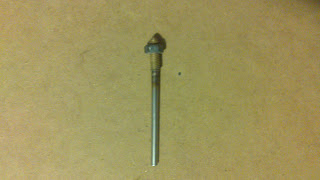Wolfgang (Stoffel15) has built a new all metal hotend which is based on it.
Instead of a fan he uses a self paced water cooling which allows him to keep the hotend very short.
As he has widened up the top of his pipe, the only way to pull it out of the cooling bar is upward. That means, if he wants to change the pipe, he must take the cooling bar out of the extruder block. Not very comfortable yet.
The pipe is fixated to the cooling bar and the heater block by grub screws. I wouldn't have chosen this solution for two reasons.
- The grub screw presses the tube against the opposite wall thus opening a gap on the side of the screw. A gap blocks the heat transmission from and towards the tube.
- The grub screw can damage the tube.
The water cooling consists of a wound up brass tube touching the cooling bar. It is difficult to say, how efficient this method is, because a round tube touching a plane doesn't have much contact.
Apart from the fact that this design has room for improvements, I like it a lot. Good job, Wolfgang. ;)
I am pleased to see what open source can do.


























